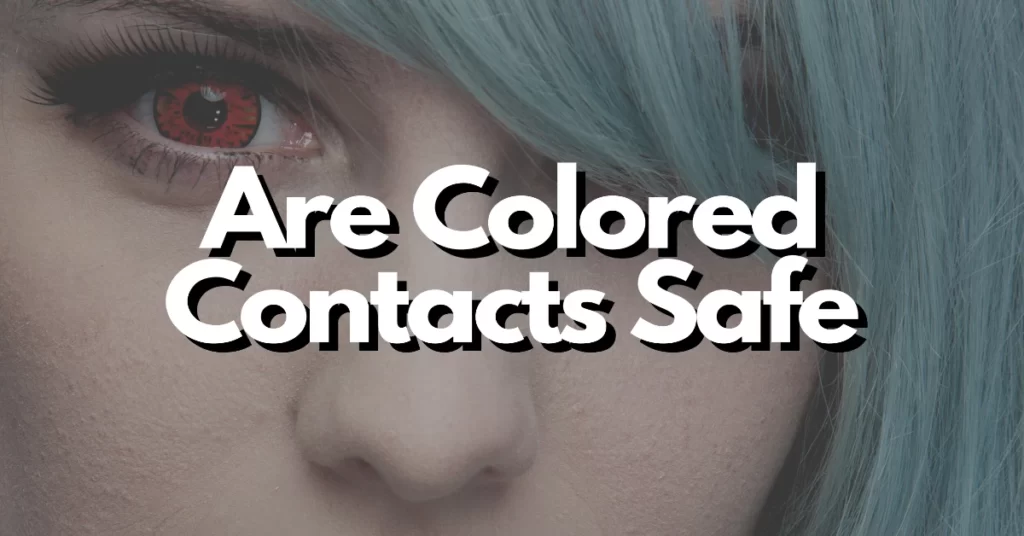Colored contact lenses have gained immense popularity in recent years, offering a fun and creative way to enhance or change your eye color. Whether you want to sport a new look for a special occasion or adopt a different eye color for everyday wear, colored contacts can be a tempting option.
However, as with any contact lens, it’s crucial to understand the potential risks and benefits to ensure your eye health remains a top priority. In this comprehensive guide, we’ll explore why people wear colored contacts, the differences between colored and standard contacts, and the potential risks associated with them.
Why People Wear Colored Contacts
Enhancing Natural Eye Color: One of the primary reasons people opt for colored contacts is to enhance their natural eye color. For example, if you have brown eyes and wish to experiment with green or blue hues, colored contacts can transform your look without the permanence of surgery.
Cosplay and Costumes: Cosplayers, actors, and individuals participating in costume events often turn to colored contacts to recreate the look of fictional characters. These lenses help achieve dramatic and attention-grabbing effects, making them an essential accessory for many costume enthusiasts.
Fashion and Style: Just as people accessorize with clothing and jewelry to express their style, colored contacts provide an additional way to enhance one’s appearance. Some individuals enjoy matching their eye color with their outfit, creating a harmonious and fashionable ensemble.
Halloween and Themed Parties: Colored contacts are a popular choice during Halloween and themed parties. They can instantly transform your look, turning you into a vampire, werewolf, or any other character that requires a unique eye color.
Differences Between Colored and Standard Contacts
Opaque vs. Enhancement Lenses: Colored contacts are available in two primary types: opaque and enhancement lenses. Opaque lenses entirely change your eye color and are suitable for individuals with both light and dark eyes. Enhancement lenses, on the other hand, are designed to intensify your natural eye color, making them appear more vibrant.
Visibility Tint: Many colored contacts have a faint visibility tint, which is often a light blue or green hue. This tint doesn’t change your eye color but makes the lens more visible during handling. Standard contacts may also have a visibility tint, although it’s usually very subtle.
Prescription vs. Non-Prescription: Colored contacts are available as prescription or non-prescription lenses. Prescription colored contacts can correct vision issues like nearsightedness or farsightedness while changing your eye color. Non-prescription lenses are purely for cosmetic purposes and don’t correct vision.
Potential Risks of Wearing Colored Contacts
While colored contacts can be a fun and versatile accessory, they do come with potential risks that should not be overlooked:
- Infections and Allergies: Just like standard contact lenses, colored contacts can cause eye infections if not handled and cleaned properly. Additionally, some individuals may be allergic to the materials used in certain lenses.
- Improper Fit: Colored contacts should fit your eyes properly to avoid discomfort and potential eye health issues. An ill-fitting lens can scratch the cornea or lead to other complications.
- Reduced Oxygen Flow: Some colored contacts, especially opaque ones, may reduce the amount of oxygen that reaches your eyes. Reduced oxygen flow can lead to eye dryness, discomfort, and even more severe issues like corneal swelling.
- Overuse and Extended Wear: Extended use of colored contacts, especially beyond the recommended duration, can increase the risk of eye problems. It’s crucial to adhere to the recommended wearing schedule provided by your eye care professional.
- Quality and Source: The quality of colored contacts can vary, and purchasing lenses from unverified or unreliable sources can be risky. Always obtain colored contacts from reputable sellers and optometrists.
Safety Precautions When Using Colored Contacts
To ensure your safety and enjoy the benefits of colored contacts:
- Consult an Eye Care Professional: Before trying colored contacts, schedule an eye exam with an optometrist. They will assess your eye health, provide a prescription if needed, and recommend suitable lenses.
- Follow Proper Hygiene: Strictly adhere to proper lens hygiene, including cleaning, disinfecting, and storing the lenses in a suitable contact lens solution. Wash your hands thoroughly before handling lenses.
- Observe Wearing Schedule: Stick to the prescribed wearing schedule for your lenses. Extended wear or sleeping in colored contacts can increase the risk of complications.
- Choose Reputable Brands: Purchase colored contacts from reputable brands and authorized sellers. Be cautious of very low prices or counterfeit products.
- Seek Immediate Assistance: If you experience discomfort, redness, pain, or changes in vision while wearing colored contacts, remove them immediately and consult your eye care professional.
Conclusion
In conclusion, colored contacts can be a fun and creative way to experiment with your appearance. However, it’s essential to prioritize your eye health by taking necessary precautions and consulting an eye care professional.
When used correctly and responsibly, colored contacts can provide a safe and enjoyable means of enhancing your look.
